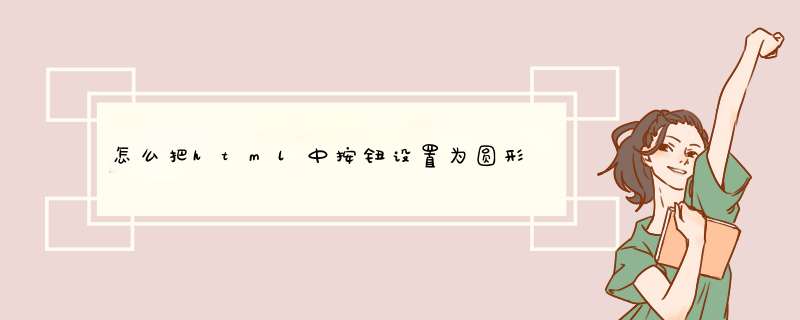
把html中按钮设置为圆形很简单,只需要将按钮的border-radius属性设置50%,同时将宽和高设置相同即可并去除边框线。具体实现代码如下:
<!doctype html>
<html>
<head>
<meta charset="UTF-8">
<title>Document</title>
</head>
<body>
<input type="button" value="按钮" style="width: 50pxheight: 50pxborder-radius: 50%border: none">
</body>
</html>
运行效果如图
扩展资料:
HTML的特点
1、简易性:超级文本标记语言版本升级采用超集方式,从而更加灵活方便。
2、可扩展性:超级文本标记语言的广泛应用带来了加强功能,增加标识符等要求,超级文本标记语言采取子类元素的方式,为系统扩展带来保证。
3、平台无关性:虽然个人计算机大行其道,但使用MAC等其他机器的大有人在,超级文本标记语言可以使用在广泛的平台上,这也是万维网(WWW)盛行的另一个原因。
4、通用性:另外,HTML是网络的通用语言,一种简单、通用的全置标记语言。它允许网页制作人建立文本与图片相结合的复杂页面,这些页面可以被网上任何其他人浏览到,无论使用的是什么类型的电脑或浏览器。
参考资料:百度百科——HTML
教程参考Colin Garven提出的实现圆形进度按钮的思路。我们将使用Jake Archibald讲过的SVG素描动画技术来实现圆形进度过程,然后提供一个成功或失败的状态来显示完成后的最终状态。今天给大家展示如何实现一个漂亮的进度按钮的思路,这个思路来自于Colin Garven的不可思议的提交按钮。我们首先看一下实现这个思路需要的步骤,顺便欣赏一下这个动画^^。正如Colin在评论中提到的,实现这个按钮背后的想法如下:一旦点击,提交按钮就变成一个圆环,并且使用这个圆环的边界展示一个进度动画。当这个进度动画完成时,按钮将再次恢复成原来大小,同时会显示一个标记用来确认提交已完成。接下来我们将完成这个思路,并且针对提交失败的情况我们添加另一个标记。
如果只考虑CSS技术,也是有可能实现这样的按钮和动画效果的。其中最具挑战的部分还是环形的进度效果,这里提供一个聪明的技巧——使用Clip属性来实现进度效果。关于这个技巧,Anders Ingemann写了一篇详实的教程。但是这次我们还是基于SVG技术,CSS转换和一点儿JavaScript来实现。关于环形进度效果和叉号,我们将使用Jake Archibald介绍的动画素描技术。
需要注意的是动画SVG在浏览器的兼容上还是存在问题,这些类型的技术仍在起步阶段,所以本教程只用来实验练习,期待在未来可以派上用场。
所以,让我们开始吧。
如果你有仔细观察Colin的Dribbble上展示的效果动画,可能已经注意到,我们需要关注按钮的几个状态。
有意思的部分是按钮从一个状态转换成另一个状态。
首先,我们要使用透明背景和边框颜色来展示一个简单的按钮,鼠标悬停时,我们使用边框色来填充该按钮,并且把按钮上的文本变成白色。
AnimatedProgressButton01_hover (1)
当我们点击按钮(例如,为了提交一个表单),我们要淡出文本,减少按钮的宽度使它变成一圆圈,并且使按钮的边框变厚,在边框上开始一个进度动画。我们将使用SVG圆圈来实现进度动画,因此我们需要确保动画开始的瞬间,按钮圆圈和SVG圆圈大小一致,位置一致。然后我们绘制圆的边线,模拟提交的过程。
AnimatedProgressButton02_progress
一旦提交完成,即边线都绘制完。我们必须使按钮再次扩大到原来大小,并且在提交成功时绘制对号,把按钮的颜色变成相应的颜色。
AnimatedProgressButton03_success
提交失败的情况下,我们也需要一个错误状态的风格。
AnimatedProgressButton04_error
接下来,让我们创建标记与我们所需要的元素。
为创建我们的标记,我们需要一个主容器,一个按钮(其中有包含文本的一个span元素)和三个SVG:
<!-- progress button -->
<div id="progress-button" class="progress-button">
<!-- button with text -->
<button><span>Submit</span></button>
<!-- svg circle for progress indication -->
<svg class="progress-circle" width="70" height="70">
<path d="m35,2.5c17.,0 32.5,14. 32.5,32.5c0,17. -14.,32.5 -32.5,32.5c-17.,0 -32.5,-14. -32.5,-32.5c0,-17. 14.,-32.5 32.5,-32.5z"/>
</svg>
<!-- checkmark to show on success -->
<svg class="checkmark" width="70" height="70">
<path d="m31.5,46.5l15.3,-23.2"/>
<path d="m31.5,46.5l-8.5,-7.1"/>
</svg>
<!-- cross to show on error -->
<svg class="cross" width="70" height="70">
<path d="m35,35l-9.3,-9.3"/>
<path d="m35,35l9.3,9.3"/>
<path d="m35,35l-9.3,9.3"/>
<path d="m35,35l9.3,-9.3"/>
</svg>
</div><!-- /progress-button -->
我们预先使用Method Draw(一个易于使用的在线SVG编辑器)绘制对号和叉号。所有SVG的尺寸为70×70,因为我们按钮的高度为70像素。我们希望圆的边线为5像素,这样看起来更像Colin的效果。当我们在图形编辑器中绘制时,需要设置正确的半径,整个圆连同它的边线为70像素。需要注意在SVG中边线为半嵌入式(即一半在圆内一半在圆外),例如,边线为2,半径为10的圆,它的宽和高为20+2,而不是10+4(边线的2倍),因此公式为2r+边界。所以在我们的案例中我们知道2r+5 = 70,因此我们需要一个半径为32.5的圆。最终得到的形状为:
<circle cx = "35" cy="35" r="32.5"/>
不幸的是,我们不能仅仅使用这个基本的形状,因为“路径”的起点在浏览器中是不同的,所以我们不能控制“进度动画”的起始点。所以,我们需要把这个圆转成路径,而不是(上面的基本形状)。你可以使用Method Draw中Object菜单下的Convert to Path很容易实现。
叉号我们将使用4个路径,这样我们可以从中心点开始绘制,使它看起来跟对号的动画类似。
现在我们有了我们需要的所有元素。让我们想想 *** 作的流程,开始样式!
首先,我们需要给按钮容器添加样式。它就像按钮的外层皮肤,让我们使它更像一个按钮,我们把它的显示设置为inline-block。这样我们可以在文档流里使用它。
.progress-button {
position: relative
display: inline-block
text-align: center
}
我们的按钮需要一些着色和排版,为了让它看起来更像Colin的按钮,我们需要设置正确的边框,使用Montserrat字体:
.progress-button button {
display: block
margin: 0 auto
padding: 0
width: 250px
height: 70px
border: 2px solid #1ECD97
border-radius: 40px
background: transparent
color: #1ECD97
letter-spacing: 1px
font-size: 18px
font-family: 'Montserrat', sans-serif
-webkit-transition: background-color 0.3s, color 0.3s, width 0.3s, border-width 0.3s, border-color 0.3s
transition: background-color 0.3s, color 0.3s, width 0.3s, border-width 0.3s, border-color 0.3s
}
我们还需要为那些将使用动画的属性添加一个过渡效果,如background-color,width等等。
在鼠标悬停时,我们将更改背景色和字体色:
.progress-button button:hover {
background-color: #1ECD97
color: #fff
}
让我们移除任何高亮的轮廓:
.progress-button button:focus {
outline: none
}
所有的SVG需要绝对定位在中心位置,并且我们将不允许任何pointer-events:
.progress-button svg {
position: absolute
top: 0
left: 50%
-webkit-transform: translateX(-50%)
transform: translateX(-50%)
pointer-events: none
}
因为我们只想 *** 作边线,所以路径不应该有任何填充。路径除了在特殊状态下,其他状态都不需要展示它们,所以我们通过设置它们的透明度为0来隐藏它们。
.progress-button svg path {
opacity: 0
fill: none
}
我们的进度环将通过设置圆形路径的边线为5来实现:
.progress-button svg.progress-circle path {
stroke: #1ECD97
stroke-width: 5
}
成功/错误的指示符号将由细的白色边线绘制,我们还将设置边线的linecap为round,这样看起来更加柔和。这两个符号都会有一个快速的不透明度的过渡效果。
.progress-button svg.checkmark path,
.progress-button svg.cross path {
stroke: #fff
stroke-linecap: round
stroke-width: 4
-webkit-transition: opacity 0.1s
transition: opacity 0.1s
}
现在让我们回顾一下,记住我们的总体规划。我们需要可以“样式化”按钮和它的特殊元素的三种额外状态(除了默认状态),加载状态,成功和错误的状态。因此我们将使用类“loading”,”success”,”error”来表示这三种状态。
当我们开始加载过程时,这个按钮将转变成一个圆,看起来更像一个表示进度的圆环。
.loading.progress-button button {
width: 70px/* make a circle */
border-width: 5px
border-color: #ddd
background-color: transparent
color: #fff
}
还记得么,我们在定义按钮样式时已经设置了过渡效果。
当我们开始进度动画时,文本应该快速淡出。
.loading.progress-button span {
-webkit-transition: opacity 0.15s
transition: opacity 0.15s
}
……通过设置opacity为0:
.loading.progress-button span,
.success.progress-button span,
.error.progress-button span {
opacity: 0/* keep it hidden in all states */
}
当从加载状态变成成功或错误的状态时,我们不需要设置过渡,只需把文本简单的隐藏掉就可以。
当我们删除所有类返回到默认状态时,我们需要稍长一点儿的时间来显示文本。所以我们需要定义不同的过渡和延时时间来回到正常的显示状态。
/* Transition for when returning to default state */
.progress-button button span {
-webkit-transition: opacity 0.3s 0.1s
transition: opacity 0.3s 0.1s
}
当我们到达最后的状态,提交成功或失败。这时我们需要重新定义一下按钮的过渡效果。
.success.progress-button button,
.error.progress-button button {
-webkit-transition: background-color 0.3s, width 0.3s, border-width 0.3s
transition: background-color 0.3s, width 0.3s, border-width 0.3s
}
接下来我们为最终状态设置颜色相关的样式:
.success.progress-button button {
border-color: #1ECD97
background-color: #1ECD97
}
.error.progress-button button {
border-color: #FB797E
background-color: #FB797E
}
当我们应用相应类的同时,需要展示SVG路径,并通过下面设置的过渡效果来实现stroke-dashoffset的动画。
.loading.progress-button svg.progress-circle path,
.success.progress-button svg.checkmark path,
.error.progress-button svg.cross path {
opacity: 1
-webkit-transition: stroke-dashoffset 0.3s
transition: stroke-dashoffset 0.3s
}
通过定义一个额外的样式类为按钮的宽度动画添加一些可选的easing
.elastic.progress-button button {
-webkit-transition: background-color 0.3s, color 0.3s, width 0.3s cubic-bezier(0.25, 0.25, 0.4, 1), border-width 0.3s, border-color 0.3s
-webkit-transition: background-color 0.3s, color 0.3s, width 0.3s cubic-bezier(0.25, 0.25, 0.4, 1.6), border-width 0.3s, border-color 0.3s
transition: background-color 0.3s, color 0.3s, width 0.3s cubic-bezier(0.25, 0.25, 0.4, 1.6), border-width 0.3s, border-color 0.3s
}
.loading.elastic.progress-button button {
-webkit-transition: background-color 0.3s, color 0.3s, width 0.3s cubic-bezier(0.6, 0, 0.75, 0.75), border-width 0.3s, border-color 0.3s
-webkit-transition: background-color 0.3s, color 0.3s, width 0.3s cubic-bezier(0.6, -0.6, 0.75, 0.75), border-width 0.3s, border-color 0.3s
transition: background-color 0.3s, color 0.3s, width 0.3s cubic-bezier(0.6, -0.6, 0.75, 0.75), border-width 0.3s, border-color 0.3s
}
如果你想研究其他的easing函数,可以使用Ceaser,这个工具是由Matthew Lein提供的CSS Easing动画工具。
目前为止样式已经OK,让我们继续我们的魔术^^
JAVASCRIPT
我们将首先初始化/缓存一些元素:button是一个HTML的按钮元素,progressEl是SVG元素用来表示圆形进度条,successEl,errorEl两个SVG元素分别用来表示对号和叉号。
function UIProgressButton( el, options ) {
this.el = el
this.options = extend( {}, this.options )
extend( this.options, options )
this._init()
}
UIProgressButton.prototype._init = function() {
this.button = this.el.querySelector( 'button' )
this.progressEl = new SVGEl( this.el.querySelector( 'svg.progress-circle' ) )
this.successEl = new SVGEl( this.el.querySelector( 'svg.checkmark' ) )
this.errorEl = new SVGEl( this.el.querySelector( 'svg.cross' ) )
// init events
this._initEvents()
// enable button
this._enable()
}
}
SVGEl.prototype._init = function() {
var self = this
this.paths.forEach( function( path, i ) {
self.pathsArr[i] = path
path.style.strokeDasharray = self.lengthsArr[i] = path.getTotalLength()
} )
// undraw stroke
this.draw(0)
}
// val in [0,1] : 0 - no stroke is visible, 1 - stroke is visible
SVGEl.prototype.draw = function( val ) {
for( var i = 0, len = this.pathsArr.lengthi <len++i ){
this.pathsArr[ i ].style.strokeDashoffset = this.lengthsArr[ i ] * ( 1 - val )
}
}
接下来我们需要给按钮绑定click事件。这个按钮最初为一个圆形动画(通过添加loading类)。该动画结束后,现有的回调函数被调用(如果在options里有指定的话)或者我们只是将进行到100%(这个“假”动画的速度与css中定义的stroke-dashoffset的过渡是相同的),在这个点时按钮是不可点击的。
UIProgressButton.prototype._initEvents = function() {
var self = this
this.button.addEventListener( 'click', function() { self._submit()} )
}
UIProgressButton.prototype._submit = function() {
classie.addClass( this.el, 'loading' )
var self = this,
onEndBtnTransitionFn = function( ev ) {
if( support.transitions ) {
this.removeEventListener( transEndEventName, onEndBtnTransitionFn )
}
this.setAttribute( 'disabled', '' )
if( typeof self.options.callback === 'function' ) {
self.options.callback( self )
}
else {
self.setProgress(1)
self.stop()
}
}
if( support.transitions ) {
this.button.addEventListener( transEndEventName, onEndBtnTransitionFn )
}
else {
onEndBtnTransitionFn()
}
}
一旦进度达到100%,我们需要重置的圆形进度条的路径。同时,我们会显示成功的对号标识或错误的叉号标识的路径。一段时间后(options.statusTime)我们“拉开”任何状态指示器的路径,再次启用按钮。注意,如图所示,我们通过CSS控制转换。
UIProgressButton.prototype.stop = function( status ) {
var self = this,
endLoading = function() {
self.progressEl.draw(0)
if( typeof status === 'number' ) {
var statusClass = status >= 0 ? 'success' : 'error',
statusEl = status >=0 ? self.successEl : self.errorEl
statusEl.draw( 1 )
// add respective class to the element
classie.addClass( self.el, statusClass )
// after options.statusTime remove status and undraw the respective stroke and enable the button
setTimeout( function() {
classie.remove( self.el, statusClass )
statusEl.draw(0)
self._enable()
}, self.options.statusTime )
}
else {
self._enable()
}
classie.removeClass( self.el, 'loading' )
}
// give it a little time (ideally the same like the transition time) so that the last progress increment animation is still visible.
setTimeout( endLoading, 300 )
}
按钮完成!
在HTML中把块的边框做成圆角需要利用css的border-radius属性。
*** 作步骤:
1、打开Adobe Dreamweaver CC 2015。
2、执行菜单栏中的"文件的新建"命令或按住Ctrl+N键打开"新建文档"对话框,选择其文档类型为HTML,单击"创建"按钮,即创建一个网页文档。
3、在<body>和</body>之间添加"<form></form>",如下图所示。表单使用的<form>标记是成对出现的,在首标记<form>和尾标记</form>之间的部分就是一个表单。
4、在<form>和</form>之间添加"<input name="text" type="submit" value="登录" class="input_box">",如下图所示。
5、在<head>和</head>之间添加"<style type="text/css"></style>",如下图所示。
6、在<style type="text/css">和</style>之间添加".input_box{width:360pxheight:40pxborder-radius:20pxborder-style:nonebackground:#ec6941font-size:14pxcolor:rgba(249,248,248,1.00)}",如下图所示。
7、保存网页文件,按住F12键可以在浏览器中预览效果,如下图所示。
语法说明
输入<input>是个单标记,必须嵌套在表单标记中使用,用于定义一个用户的输入项。
name属性:输入字段的识别名称,传递数据时的参数名称。
type属性:输入字段的类型。button是表单通用按钮。
value属性:表单字段预设数据值。例如用于button、submit、reset等字段类型指的是按钮标签的显示文字。
class属性:对应于网页中的CSS选择器名称。
欢迎分享,转载请注明来源:内存溢出

 微信扫一扫
微信扫一扫
 支付宝扫一扫
支付宝扫一扫
评论列表(0条)